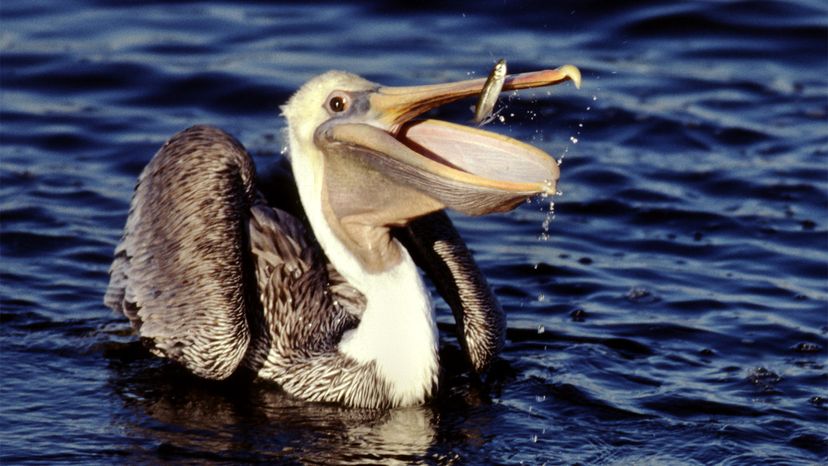Follow That Bill: Pelican Features

Pelicans are part of the order Pelecaniformes, which includes around 50 species of waterbirds. These birds are distinguished from other orders by their four webbed toes, the fact that they breathe through their mouths instead of nares (nostrils), and their tendency to feed on marine animals. The other big thing they have in common is the gular skin mentioned on the previous page. Some birds take the concept one step further. Instead of just a bare patch of skin, they have a loose, stretchy pouch that they can expand and contract. The great frigate bird, another member of the order, puffs up its gular pouch with air during courtship displays. But only the pelican has such a big pouch, and it's the only one of its order to use its pouch to catch meals. A pelican's lower mandible (the bottom half of its bill) is basically just a frame around the pouch.
Another unique feature is the hook at the tip of the pelican's upper mandible (the top half of its bill), which helps grab onto particularly slippery or wiggly fish. After locating and scooping up its prey, the pelican opens its bill and slowly contracts its pouch to empty out the water and keep the fish inside. Then, with a jerk of the bird's head, the fish slides down the hatch. If a fish is particularly large, the pelican might manipulate it so that the fish goes down head first, which helps keep it from getting stuck. A pelican can't eat or fly away if its pouch is still full of water, so the draining process is very important. By bending its neck, it can even turn its pouch inside out. The winner for sheer bill size is the Australian pelican — its bill can be up to 1.5 feet (about half a meter) long.
Advertisement
The title of this article was prompted by a famous limerick written by humorist Dixon Lanier Merritt in 1910:
A pelican's bill does have a larger capacity than its stomach. A pelican's stomach can hold up to 1 gallon (3.79 liters), while its pouch can hold up to 3 gallons (11.36 liters). That adds up to the equivalent of 8 pounds (3.63 kilograms) in the stomach and about 24 pounds (10.89 kilograms) in the pouch. While a pelican might technically be able to take enough food in its bill for a week, it doesn't store food there. If it catches more fish than it can eat at one time, the excess is stored in the pelican's esophagus.